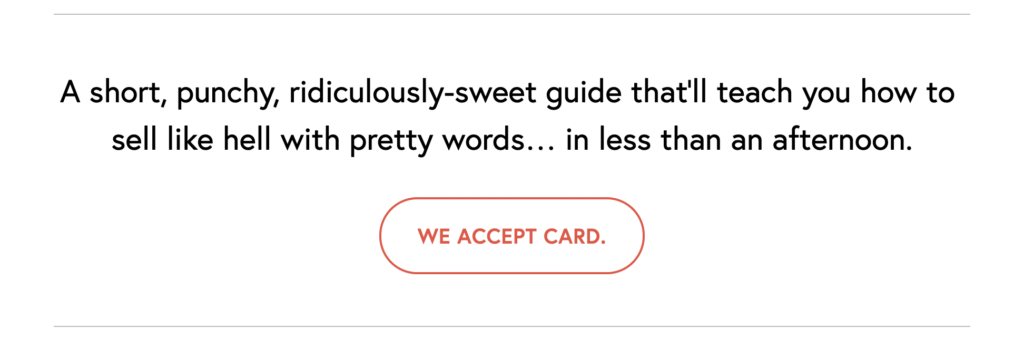Recently, I had the opportunity to interview Cole Schafer, the master/sensei of copywriting. For anyone who doesn’t know who Cole is, he runs the famous creative writing shop called Honey Copy, make-no-mistake, a six-figure revenue business, where he teaches copywriting and has a particular course for freelance copywriters. Be it going viral on medium or writing copies that raised huge funds on Kickstarter, or helping product launches, or copywriting billboards–he is someone who has pretty much done at all.
And if you have been listening to our friend Christopher Lochhead‘s Podcast – Lochhead on Marketing, then you must have heard of Cole at least a hundred times.
This post encapsulates the learnings from my interview with Cole Schafer on The ABM Conversations Podcast.
Before we start: What is copywriting?
Copywriting is the art of writing a copy. A copy can be anything ranging from a web page to sales promotion materials to ad copies to marketing materials for products, services, fundraising campaigns, and more.
The point of any copy is to persuade the reader to take action. In other words, make the targeted audience respond to the Call to Action (CTA). Again, the requested action can range from sharing the email address to downloading an ebook to buying something to donating money for a cause, and more.


Copywriting is one of the most critical components of marketing, sales and advertising. Having had the opportunity to converse with a master copywriter, I wanted to document my understanding of the subject and improve my writing skills.
In this post, I try to cover most things, starting from headlines to writing styles to tone of voice to CTAs. I hope reading this is a good use of your time.
The approach for writing headlines that work
Everyone has an opinion about what should be the headline’s idea, what emotion should it evoke, who should it talk to, etc. And we’ve all seen headlines that are 1-2 words and also ones that have about 18 to 20 words. And then there are tools like Sharethrough that give you a headline score.
Cole recommends that everyone follows the 20% rule when it comes to copywriting headlines. And what that essentially means is when you’re sitting down to write an email, a sales letter, a web page, make sure that you are spending 20% of the time you took to write the full copy to come up with a good headline.
There’s a sort of this phenomenon, or something about the human condition, where we assume that if we put a lot of time and work into copywriting something or creating something, then the world will sort of telepathically know that we had put in the hard work and that they owe us to read it or watch it or list 🙂 Unfortunately, that’s not how marketing works.
And so what Cole encourages people to do is – let’s say you’re spending an hour copywriting a headline, makes sure you are putting aside 20% of that time to sit down and write out a bunch of headlines. Media companies like Buzzfeed have all of their writers come up to 25 headlines for every article they write. They do it because they found not just an increase in conversion by 10% or 20%, but an increase in 500% click-throughs to go on those articles.
So the fastest way you could improve your headline writing is just by spending more time copywriting the headlines than your core piece of content is possible.
The different styles of writing headlines
There are so many different approaches to copywriting headlines, and if you talk to other copywriters, they’ll give you their take. Interestingly, Cole categorizes headline styles into three different buckets.
First bucket: It is this idea of flirting with the reader. In this case, you might be making one small change to your email subject line, and it could potentially increase your open rates by 20%. The idea is you are showing the reader the door but not explicitly telling them what’s behind the door. You leave it up to them to open it. In short, you’re flirting with them.
Second bucket: It goes in the opposite direction to the first bucket. It is a style where you tell your readers exactly what the article is about. Just shoot them straight. And the approach works if that’s the style your brand is known for.
Third bucket: This one involves understanding what your reader or a customer might be dealing with, from a pain aspect and then writing directly to that. It’s more towards offering a solution to a problem.
Building trust with your audience
A lot of business content is boring. It doesn’t even feel like it’s written for a person. So how do you go about building trust with our readers using the written word?
Fundamentally, building trust is all about doing what you say you’re going to do for someone. Be it a customer, vendor, employee or friend. That said, you can build trust with your audience by keeping your copywriting simple. Some people write to sound smart, whereas some people write to be understood. But if there’s one person to get inspired from, it’s Ernest Hemingway. He used simple words that created rhythms.
The Hemingway method of copywriting
Ernest Hemingway was known for having this copywriting style that was absent of any fat. Rarely did he use big, big words or anything like that. People love him because if you were highly educated, you could read him and thoroughly enjoy his work and be introduced to these big ideas.
If you didn’t have anything past a seventh-grade education, you could still read his novels and not need a dictionary right beside you. That was the beautiful thing about Hemingway. And that’s what made his writing so famous was that it was approachable. It was digestible for the masses. There hadn’t been many writers previous to him that we’re able to do that in such a lovely way.


Where the Ernest Hemingway method plays into copywriting is – keeping it simple. Stop using words like synergy. Stop using words with three or four or five syllables. When there is a word with five letters, and it gets your point across perfectly fine, what’s the need to complicate things?
Instead, if you want to sound smart by using complex words – remember, it just makes you harder to understand. So that would mean people need to stop using slang and jargons.
Identifying your tone of voice
Another interesting factor to keep in mind is your tone of voice as part of your copywriting. Cole sees it as an exciting process and says that when working with a new brand that wants to develop a more contemporary voice, he encourages them to stop looking at their brand as a brand and instead look at their brand as a person.
And so how you go about doing that is, let’s say we are copywriting for Nike. Let’s take Nike and say if Nike were a person, what would their name be? Would it be a he or she? What kind of conversations would we have at the dinner table? If we were talking with them, what music would he or she listen to? What sports would they play?


When you start doing that, all of a sudden, you can create this persona for your brand. That’s that it no longer feels like a massive organization but like a person. What’s fascinating about individual people is that they have personalities. And so that’s where you can develop a style for your brand.
It’s when you realize, okay, my brand isn’t a brand, but instead, it’s this embodiment of a person and being that a person has personality, our brand has to have personality too. It just happens when your leadership is willing to sit down and have those conversations internally about who they are in terms of a brand, so on and so forth.
A copywriting case study: Samsara Luggage
I saw a landing page that Cole Schafer wrote for Samsara – a suitcase company that raised about $140K in crowdfunding. And I wanted him to explain it to me as a case study for copywriting for a landing page that converts well.
For starters, Samsara is a luggage company based in Israel. As you would expect, Cole gives a lot of credit to the product first. He says, “My copy was solid for the site but that they had an exceptional product made my job a lot easier.”
Here’s how he went on with writing the copy. For him, it felt like he was working with the Tesla of suitcases. And that helped him frame it in his mind that someone who would buy a Tesla might be the exact kind of person who would also buy a Samsara.
So before he sat down and started writing all of this copy for this landing page, he asked the kind of questions discussed above to discover the personality of people who would buy the suitcase.
He identified that they would be a business traveller who was constantly on the move or some probably in sales or business development where they’re constantly on their laptops or phones. So, when these folks get to an airport, they aren’t just chilling or having a cup of coffee or reading a book.
But instead, they’re at the airport; they are sending out emails, coordinating travel plans, planning the next meetings. Samsara- the Luggage piece had a battery built in it, which allowed them to charge their phones and their laptops, and it doubled as an actual desk. So, you can just set your laptop on the piece of Luggage and start writing a book on your laptop and use it as a desk in miniature.
But, to be more specific – you need to understand a couple of psychological aspects of copywriting. Every copy needs to do one of the two – either move customers closer to pleasure or move them further away from pain. That’s why we buy.
If we consider ourselves right now, like let’s say I was working at a large company and today someone offered me a promotion, right. I call it my wife or my partner, and I let them know, “Hey, I just got a promotion.”
And probably on the way home, I’d pick up an expensive bottle of wine to celebrate that purchase is moving me closer to pleasure. When I get home, we have the wine. We go out to a nice dinner (again, a purchase that moves us closer to pleasure).
The following day I wake up, and I have a hangover. So now I need Advil. And I don’t have any in the house. So I have to leave the house. And before work, I stopped by the CVS to pick up some Advil. Now, this purchase is moving me further away from pain.


And then, on the way to work, I get a flat tire, and I have to call someone to come by and fix that tire. That purchase is moving me again, further away from pain. So, pretty much every purchase happens to either move a customer closer to pleasure or move the customer further away from pain.
So when he understood the users and the use case, he could step into the shoes and make the copy resonate better. And it raised more than $140K in a short span, so it worked.
So, does pain vs pleasure theory of copywriting for Saas?
Some of the fascinating companies are the companies that cater to both ‘relieving from pain’ and ‘moving towards pleasure.’ But that’s very rare.
So every time you are stuck with the thought of how to simplify your product or feature to your customer, challenge yourself and see if it’s moving someone closer to the pleasure or is it moving someone further away from pain?


Take Freshbooks as an example:
Cole is a solopreneur, a freelancer. He uses Freshbooks for all of his invoicing. He uses Freshbooks for all his invoicing because it moves him further away from pain because creating invoices, sending them out to clients, trying to figure out how he is going to get those clients to pay him on time.
He’s always trying to figure out what payment processing system they will use to pay him and that all the hours it’s going to take each week. But with Freshbooks, he says, he could quickly send out an invoice in less than 60 seconds. It goes in their inbox. He’s told whether or not they’ve opened it. So he knows if they are either delaying paying me or if they just haven’t seen it yet.
And then Freshbooks have payment processing built into the invoice. So Cole can tell his clients, “Hey, you don’t have to PayPal me or send me a check. You can just whip out your credit card and pay me directly on the invoice.” That entire system that FreshBooks offers moves him as a freelancer, moves him further away from pain.
One CTA vs too many CTA – what works better?
When I looked at Honey Copy, one thing vividly stood out for me. The landing pages for each of his courses have multiple CTAs. Pretty much every fold has a CTA. And those CTAs aren’t regular looking CTAs. Some of those CTAa are – ‘I’m legit, ‘Bon Appetit’, ‘I quit’, etc. And they all point to the same buying page on Gumroad.
So I had to ask – why multiple CTAs, and how does it work for his use case?


Here’s what Cole had to say:
“So this is, this is more so just a theory that I have right now, and for Honey Copy, it’s worked well. I’m not saying it’s going to work for everyone, but readers tend to fall into three different buckets. You have your readers who start from the first sentence and read all the way down, without skipping any lines. And they’re super, super detailed, right?
You have another set of readers who might read the first line or the first sentence, and then they skim the rest of the way down the page for headlines, for whatever.
You have a whole set of readers who may read the first sentence but then go straight down the page to see the conclusion.
Understanding that probably only 10% of readers are reading every single sentence and that most of my readers are skimmers or readers who like jumping around on the page, I thought it’s imperative to have multiple CTAs throughout the page. I didn’t want to have just one CTA down at the very bottom of the page because it allows you to get more clicks on the page. So, that’s one idea.
The other idea is that as a customer, you might mostly decide within three seconds or three sentences that you’re ready to buy, right?”
Final tips on writing a great copy…
So there’s a theory on living well, and the idea is that to have a good life, it’s simply about stringing together a series of really, really good days.
And that theory can apply to copywriting. Whether it is about copywriting for a sales page or writing an entire book to create something ultimately good, it’s writing a really good sentence in its most basic form.
Just write one good sentence and then make your following sentence good. And then make the third sentence good.
So, do it. Rinse and repeat.
